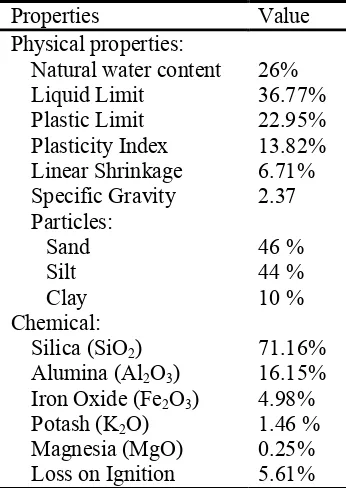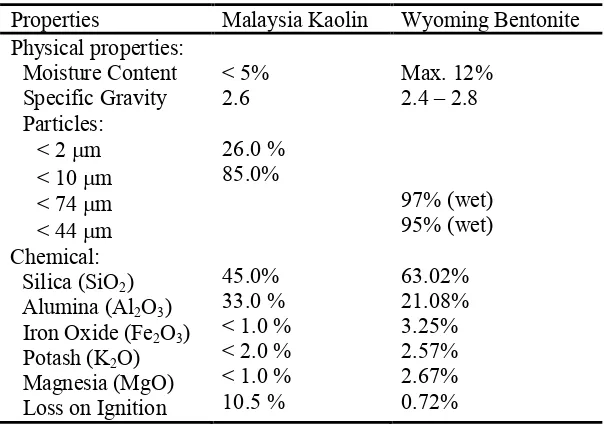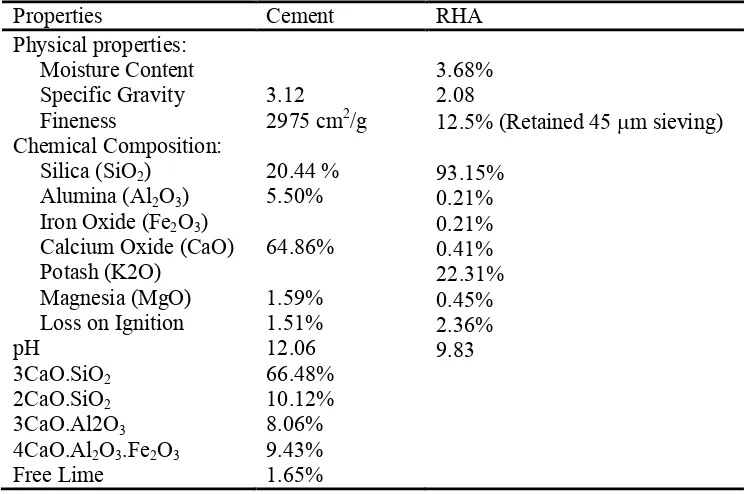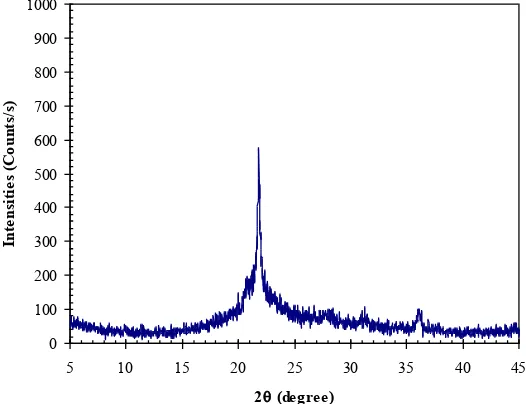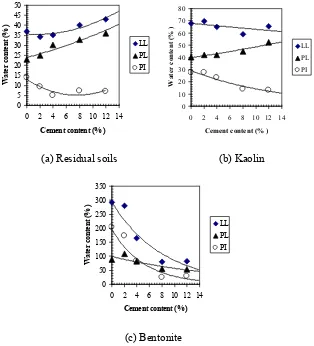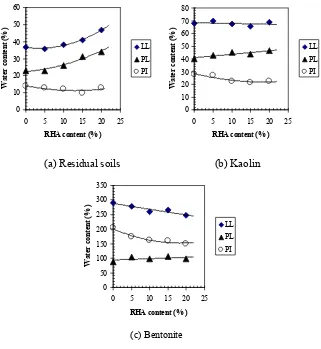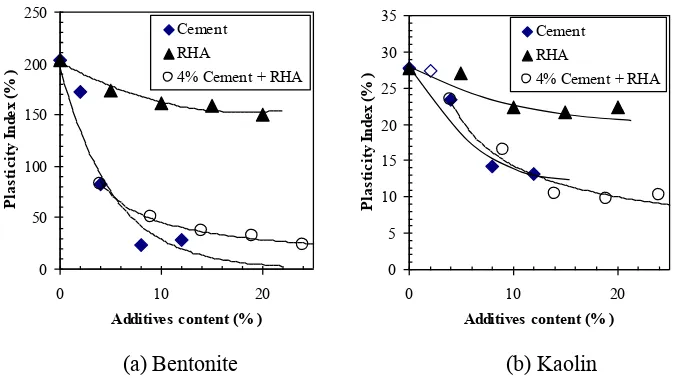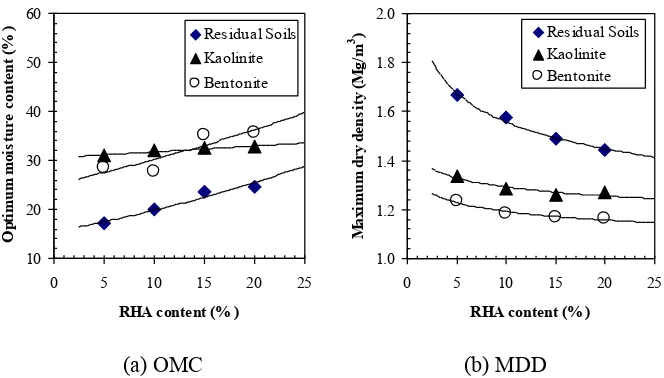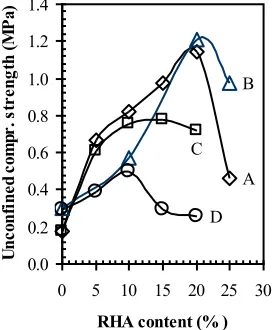STABILIZATION OF CLAY
AND RESIDUAL SOILS USING
CEMENT - RICE HUSK ASH MIXTURES
Ehammed A. Basha, Roslan Hashim and Agus Setyo Muntohar
Abstract
The well established techniques of soil stabilization often use such cementing agents as Portland cement, lime, etc. Replacement of those cementing materials with industrial or agricultural by-product is highly desirable. Rice husk ash is a very potential paddy crop waste as pozzolanic materials which result in a superior properties when combined with cement or other cementing agents. This paper presents the laboratory study on the stabilized soils with cement and rice husk ash. The experimental study included the evaluation of such properties of the soil as consistency limits, compaction, unconfined compressive strength, and X-Ray diffraction. Three types of soils are used in this study i.e granite residual soils, kaolinite clay and montmorillonite clay (bentonite). Test results show that both cement and rice husk ash reduces the plasticity of soils. In term of compactability, addition of rice husk ash and cement decreases the maximum dry density and increases the optimum moisture content. From the viewpoint of plasticity, compaction and strength characteristics, and economy, addition of 6 – 8 percent cement and 10 – 15 percent rice husk ash are recommended as an optimum amount for soils stabilization.
INTRODUCTION
Stabilised soils are, in general, composite materials that result from combination and optimisation of the properties of individual constituent materials. The well-established techniques of soil stabilisation are often used to obtain improved geotechnical materials through either the addition to soil of cementing agents such as Portland cement, lime, asphalt, etc.
As a result of the increase in the amount of solid waste all over the globe, engineers and researchers carry out many investigations to find the uses for such wastes. Environmental and economic issues in many countries have inspired interests in the development of alternative materials that can fulfil design specifications. The transportation, construction, and environmental industries have the greatest potential for re-use because they use vast quantities of earthen materials annually. Replacement of natural soils, aggregates, and cement with solid industrial by-product is highly desirable. In some cases, a by-product is inferior to traditional earthen materials, but its lower cost makes it an attractive alternative if adequate performance can be obtained. In other cases, a by-product may have attributes superior to those of traditional earthen materials. Often select materials are added to industrial by-products to generate a material with well-controlled and superior properties.
Mehta (1985) studied the possibility of using fly ash in cement and concrete works. Investigators such as Gidley and Sack (1984) proposed several methods for utilizing some industrial wastes in engineering construction. Tay (1987) studied the use of sludge ash in portland cement concrete works. Other studies examined the possibility of improving soil properties such as increasing shear strength, reducing settlement, and minimizing swelling problems by using solid waste. Kamon and Nontananandh (1991) combine industrial waste with lime to stabilize soil. Atom and Al-Sharif (1998) evaluated burned olive waste for use as soil stabilizer, which a partial solution to the problems associated with the increase of olive waste in Jordan.
found in the forms of free salts and particles of cationic groups combined with the anionic groups of the fibres into such plants (Rydholm, 1965).
Figure 1 Rice husk disposal at the rice mill in Kuala Selangor, Malaysia
Incineration of organic materials, production of new crystalline
phases, or crystallization of amorphous material are exothermic processes
that lead to ash production and loss in the total weight. The result of
burning organic materials is called thermal decomposition. The ash
produced in this way is ground to a fine size and mixed with lime in order
to obtain a material with a binding characteristic. The quality of this
material depends on burning time, temperature, cooling time, and grinding
conditions (James, and Rao, 1986a, 1986b). The primary objective of this
study is to examine the potential of burnt agricultural by-products, rice
husk, for using this material for stabilising soils. The effects on the
consistency, density, and strength of some various soil types are studied.
EXPERIMENTAL INVESTIGATION
Materials Used
Clay and Residual Soils
used. Figure 2 shows the diffractograph of the soils. Kaolinite clay mineral was identified in the residual soil by its strong diffraction line at 3.57 Å, which disappeared when heated to 550o C. Kaolinite was also detected in the kaolin by its strong diffraction lines at 7.13 Å and 3.56 Å. The two peaks remain, even though their intensities were significantly reduced, after heating. Wyoming bentonite was predominantly comprised of Na-montmorillonite.
Table 1 Properties of the Residual Soil
Properties Value
Physical properties: Natural water content Liquid Limit
Plastic Limit Plasticity Index Linear Shrinkage Specific Gravity Particles:
Sand Silt Clay Chemical:
Silica (SiO2)
Alumina (Al2O3)
Iron Oxide (Fe2O3)
Potash (K2O)
Magnesia (MgO) Loss on Ignition
26% 36.77% 22.95% 13.82% 6.71% 2.37 46 % 44 % 10 % 71.16% 16.15% 4.98% 1.46 % 0.25% 5.61%
Rice husk ash
Cement
The cement used was general portland cement. The physical and chemical properties of the cement are given in Table 3.
Table 2 Properties of used clay (kaolin and bentonite) Properties Malaysia Kaolin Wyoming Bentonite Physical properties:
Moisture Content Specific Gravity Particles:
< 2 m < 10 m < 74 m < 44 m Chemical:
Silica (SiO2)
Alumina (Al2O3)
Iron Oxide (Fe2O3)
Potash (K2O)
Magnesia (MgO) Loss on Ignition
< 5% 2.6
26.0 % 85.0%
45.0% 33.0 % < 1.0 % < 2.0 % < 1.0 % 10.5 %
Max. 12% 2.4 – 2.8
97% (wet) 95% (wet)
63.02% 21.08% 3.25% 2.57% 2.67% 0.72%
Laboratory Tests
Atterberg limits tests
The Atterberg consistency limits testing and reporting was carried out in accordance with British Standard methods - BS 1377: Part 2-1990 (British Standard Institution, 1990a). The residual soil was sieved with 425 mm sieving. Materials that retained on that sieve were rejected for this test. Since the kaolin and bentonite used were either fine, no sieving was carried out. The soils, then, were oven dried for at least 2 hours before the test. The tests were carried out on the soils with different proportion of cement and rice husk ash.
Compaction tests
the optimum moisture content (OMC) of the soils. The soil mixtures, with and without additives, were thoroughly mixed with various moisture contents and allowed to equilibrate for 24 hours prior to compaction. The first series of compaction tests was aimed at determining the compaction properties of the unstabilised soils. Secondly, tests were carried out to determine the proctor compaction properties of the clay upon stabilisation with varying amounts of cement and rice husk ash.
Table 3 Physical and Chemical Properties of the Cement and RHA.
Properties Cement RHA
Physical properties: Moisture Content Specific Gravity Fineness
Chemical Composition: Silica (SiO2)
Alumina (Al2O3)
Iron Oxide (Fe2O3)
Calcium Oxide (CaO) Potash (K2O)
Magnesia (MgO) Loss on Ignition pH
3CaO.SiO2
2CaO.SiO2
3CaO.Al2O3
4CaO.Al2O3.Fe2O3
Free Lime
3.12 2975 cm2/g
20.44 % 5.50%
64.86%
1.59% 1.51% 12.06 66.48% 10.12% 8.06% 9.43% 1.65%
3.68% 2.08
12.5% (Retained 45 m sieving) 93.15%
0.21% 0.21% 0.41% 22.31% 0.45% 2.36% 9.83
Unconfined compressive tests
K (7.17A)
Q (3.34A) K (3.57A)
K (4.26A) I (4.49A)
M (3.06A) Q (3.34A) M (14.96A)
Mc (9.97A)
Q (3.34A)
K (3.57A) F (6.14A)
I/H (4.99A)
Q (4.25A)
5 10 15 20 25 30
2q (Ao)
Kaolin Bentonite Residual Soil
M: Montmorillonite, F: Feldspar, Mc : Muscovite, K : Kaolinite, Q : Quartz, I: Illite, H: Halloysite
Figure 2 X-Ray diffraction pattern of residual soil, bentonite, and kaolin
0 100 200 300 400 500 600 700 800 900 1000
5 10 15 20 25 30 35 40 45
2q (degree)
In
te
n
si
ti
e
s
(C
o
u
n
ts
/s
)
RESULTS AND DISCUSSION
Effect on the consistency limits
The effect of cement and rice husk ash (RHA) stabilised soils on the liquid limit (LL) and plasticity index (PI) on the different soils are shown in Figure 4 and 5. In this context, it was illustrated a different characteristics of each soils. Reduction in plasticity of cement/RHA stabilised - residual soils as result of increase in liquid limits and plastic limits, in contrast with cement stabilised bentonite. For cement/RHA treated kaolin, liquid limits decreases while the plastic limits increase corresponds to cement/RHA increases.
0 5 10 15 20 25 30 35 40 45 50
0 2 4 6 8 10 12 14
Cement content (% )
Wa te r c o n te n t (% ) LL PL PI 0 10 20 30 40 50 60 70 80
0 2 4 6 8 10 12 14
Cement content (% )
Wa te r c o n te n t (% ) LL PL PI
(a) Residual soils (b) Kaolin
0 50 100 150 200 250 300 350
0 2 4 6 8 10 12 14
Cement content (% )
Wa te r c o n te n t (% ) LL PL PI (c) Bentonite
It has been observed that cement and RHA reduce the plasticity of
all soils. Cement treated bentonite reduced significantly the PI of bentonite
as shown in Figure 6(a), while blend of RHA with cement indicated no
significant improvement. Cement
–
RHA mixture exhibited further
improvement for kaolinite soils as illustrated in Figure 6(b). It proved that
cement work effectively with bentonite or expansive clays. Grim (1968)
mentioned that Ca
2+cation will easily replace Na
+, this term possible
occurred in the cement stabilised bentonite. In general, 6
–
8 % of cement
and 10
–
15 % RHA shows optimum amount to reduce plasticity of soils.
Reduce in plasticity index is an indicator of improvement.
0 10 20 30 40 50 60
0 5 10 15 20 25
RHA content (% )
Wa te r c o n te n t (% ) LL PL PI 0 10 20 30 40 50 60 70 80
0 5 10 15 20 25
RHA content (% )
Wa te r c o n te n t (% ) LL PL PI
(a) Residual soils (b) Kaolin
0 50 100 150 200 250 300 350
0 5 10 15 20 25
RHA content (% )
Wa te r c o n te n t (% ) LL PL PI (c) Bentonite
0 50 100 150 200 250
0 10 20
Additives content (% )
P la s ti c it y I n d e x ( % ) Cement RHA
4% Cement + RHA
0 5 10 15 20 25 30 35
0 10 20
Additives content (% )
P la s ti c it y I n d e x ( % ) Cement RHA
4% Cement + RHA
(a) Bentonite (b) Kaolin
Figure 6 Effectiveness of Additives on PI of Kaolin and Bentonite
Effect on the compactability
Figure 7, 8, and 9 shows, respectively, the effect of the addition of
cement, RHA, and cement
–
RHA mixtures on the compaction
characteristics of the soils tested.
10 20 30 40 50 60
0 2 4 6 8 10 12 14
Cement content (% )
O p ti m u m m o is tu r e c o n te n t (%
) Residual Soils
Kaolinite Bentonite 1.0 1.2 1.4 1.6 1.8 2.0
0 2 4 6 8 10 12 14
Cement content (%)
M axi m u m d ry d e n si ty (M g/ m 3 ) Residual Soils Kaolinite Bentonite
(a) OMC (b) MDD
10 20 30 40 50 60
0 5 10 15 20 25
RHA content (% )
O p ti m u m m o is tu r e c o n te n t (%
) Residual Soils
Kaolinite Bentonite 1.0 1.2 1.4 1.6 1.8 2.0
0 5 10 15 20 25
RHA content (% )
M a x im u m d r y d e n s it y ( M g /m
3 ) Residual Soils
Kaolinite Bentonite
(a) OMC (b) MDD
Figure 8 Variation of Compaction Characteristics of the Soils With RHA Content
0 10 20 30 40 50 60
0 5 10 15 20 25
RHA content (% )
O p ti m u m m o is tu r e c o n te n t (% ) Residual Soils Kaolinite Bentonite 1.0 1.2 1.4 1.6 1.8 2.0
0 5 10 15 20 25
RHA content (% )
M a x im u m d r y d e n s it y ( M g /m
3 ) Residual Soils
Kaolinite Bentonite
(a) OMC (b) MDD
Figure 9 Variation of Compaction Characteristics of the Soils With 4% Cement - RHA Mixtures
increases as shown in Fig. 8. The same characteristics can be observed also
when 4% cement was blended with RHA as illustrated in Fig. 9. The
increase in optimum moisture content is probably a consequence of two
reason: (1) the additional waster held with the flocculants soil structure
resulting from cement interaction, and (2) exceeding water absorption by
RHA as a result of its porous properties, as reported in Zhang et. al (1996).
Principally, increase in dry density is an indicator of improvement. But
unfortunately, both cement and RHA, instead, reduce the dry density.
Rahman (1987) revealed an opinion that the change-down in dry density
occurs because of both the particles size and specific gravity of the soil and
stabiliser.
Decreasing of dry density indicates that it needs low compactive
energy (CE) to attain its maximum dry density, as the result the cost of
compaction will be economical (Muntohar and Hantoro, 2000).
Effect on the compressive strength
The effect of the addition RHA and cement individually on the
unconfined compressive strength of various soils are shown in Figure 10.
Cement is, undoubtedly, an effective additive to enhance the strength of
tested soils. In Fig. 10a, it can be observed that the optimum cement content
is 8%. It corresponds with optimum cement content that reached on the
consistency limit. In contrast with RHA
–
soil mixtures, Figure 10b, the
RHA slightly increase the strength because of the lack of cementitious
properties in RHA as presented in Table 2. In agreement with Hossain
(1986), hence, RHA cannot be used lonely for stabilisation of soil. This
investigation shows that cement
–
stabilised can be intensified by adding
between 15
–
20% of RHA as shown in Figure 11. The figure either shows
A B C 0.0 0.1 0.2 0.3 0.4 0.5
0 2 4 6 8 10 12 14
Cement content (% )
U n c o n fi n e d c o m p r . s tr e n g th ( M P a ) A B C 0 0.1 0.2 0.3 0.4 0.5
0 5 10 15 20 25
RHA content (% )
U n c o n fi n e d c o m p r . s tr e n g th ( M P a )
(a) Cement stabilised soil (b) RHA stabilised soil
Figure 10 Effect of the addition of RHA and cement of unconfined compressive strength A B C D 0.0 0.2 0.4 0.6 0.8 1.0 1.2 1.4
0 5 10 15 20 25 30
RHA content (% )
U n c o n fi n e d c o m p r . s tr e n g th ( M P a )
Figure 11 Effect of the addition of RHA on the 4% cement – soil mixtures
Resistance to immersion (Ri)
Resistance to immersion in the unconfined strength of 4% cement
–
RHA
–
residual soil mixtures are presented in Table 4. A stabilised soil
should have the resistance of its integrity and services
–
strength along the
A: Residual Soil B: Kaolin C: Bentonite
lifetime of construction. This experiment exhibits that the by addition of
RHA in cement
–
residual soil mixtures have better resistance subject to 7
days immersion. It can be seen that the strength of residual soil mixed with
4% cement and five different RHA content drop-down to 89%, 75%, 95%,
89%, 83%, and 57% respectively for 0, 5, 10, 15, 20, and 25 percent RHA.
Mix of 5, 20 and 25 % RHA with 4% cement have greater reduction of
strength than cement only. But, the strength raised are still higher than
cement stabilised residual soil.
Table 4 Resistance to immersion in the unconfined strength of 4% cement – RHA – residual soil mixtures at OMC + 3% water content
Soil + Additives Unsoaked Soaked Ratio
4% Cement + RHA MPa MPa Soaked/Unsoaked
0% 0.993 0.882 0.89
5% 2.203 1.654 0.75
10% 3.305 3.151 0.95
15% 3.72 3.309 0.89
20% 3.646 3.011 0.83
25% 3.299 1.873 0.57
CONCLUSIONS
The following conclusions can be drawn on the basis of the test
results obtained from cement
–
RHA stabilised soils.
(1) Cement and rice husk ash reduced the plasticity of residual soil, kaolin, and bentonite. A considerable reducing was attained by cement-stabilised soils. Each soil type exhibited a specific characteristic of reduction.
(2) The maximum dry density of cement – stabilised residual soil and kaolin slightly decreased with increase in cement content, in contrast with cement-stabilised bentonite. Adding rice husk ash and cement increase the optimum moisture content of all soils.
a better improvement. Since cement is more costly than RHA this can result in lower construction cost.
(4) In general, 6 – 8 % of cement and 10 – 15 % RHA shows optimum amount to improve the properties of soils. Reduce in plasticity index and increasing of strength and resistance to immersion are indicator of improvement.
(5) Rice husk ash can potentially stabilise the expansive and non-expansive soils solely or mixed with cement. The utilising is an alternative to reduce construction cost, particularly in the rural area of developing countries.
REFERENCES
Mehta, P.K., 1985, Influence of fly ash characteristics on the strength of portland
– fly ash mixtures, Cement Concrete Research, Vol. 15, pp. 669¯674.
Gidley, J.S. and Sack, W.S., 1984, Environmental aspects of waste utilization in construction, Journal of Environmental Engineering, ASCE Vol. 110 (6), pp. 1117 – 1133.
Tay, J.H., 1987, Sludge ash as filler for portland cement, Journal of Environmental Engineering, ASCE Vol. 113, pp. 345 – 351.
Kamon, M., and Nontananandh, S., 1991, Combining industrial wastes with lime for soil stabilization, Journal of Geotechnical Engineering, Vol. 117, pp. 1 – 17.
Attom M.F., and Al-Sharif M.M., 1998, Soil stabilization with burned olive waste, Applied Clay Science, Vol. 13, pp. 219 – 230.
Rydholm, S.A., 1965, Pulping Processes, Interscience Publishers, New York, p. 1049 – 1053.
James, J., and Rao, S.M., 1986a, Silica from rice husk through thermal decomposition, Thermochimica Acta, Vol. 97, pp. 329 – 336.
James, J., and Rao, S.M., 1986b, Reactivity of rice husks ash, Cement and Concrete Research, Vol. 16, pp. 296 – 302.
Payá, J., Monzó, J., Borrachero, M.V., Mellado, A., and Ordoñez, L.M., 2001,
Determination of amorphous silica in rice husks ash by rapid analytical method, Cement and Concrete Research, Vol. 31, pp. 212 – 231.
British Standard Institution, 1990a, Methods of test for soils for civil engineering purposes, BS 1377 – 1990: Part 2, and 4,.
British Standard Institution, 1990b, Stabilized materials for civil engineering purposes, BS 1924 – 1990: Part 2 - Section 4,.
Zhang, M.H., Lastra, R., and Malhotra, V.M., 1996, Rice husk ash paste and concrete: Some aspects of hydration and the microstructure of the interfacial zone between the aggregate and paste, Cement and Concrete Research, Vol. 26 (6), pp. 963 – 977.
Rahman, M.A., 1987, Effect of cement-rice husk ash mixtures on geotechnical properties of laterite soils, Journal of Soils and Foundations, Vol. 27 (2), pp. 61-65.
Muntohar, A.S., and Hantoro, G., 2000, Influence of the Rice Husk Ash and Lime on Engineering Properties of Clayey Subgrade, Electronic Journal of Geotechnical Engineering, Vol.5 – 2000, Paper#019, Oklahoma State University, USA.
Hossain, A.S.M.M., 1986, Cement and cement – rice husk ash stabilisation of selected local alluvial soils, M.S. Thesis, Department of Civil Engineering, Bangladesh University of Engineering and Technology, Dhaka.
CURRICULUM VITAE
Ehammed Abdurrahman Basha is Ph.D candidate at Department of Civil and Environmental Engineering, University of Malaya.
Roslan Hashim is Professor at Department of Civil and Environmental Engineering, University of Malaya.

